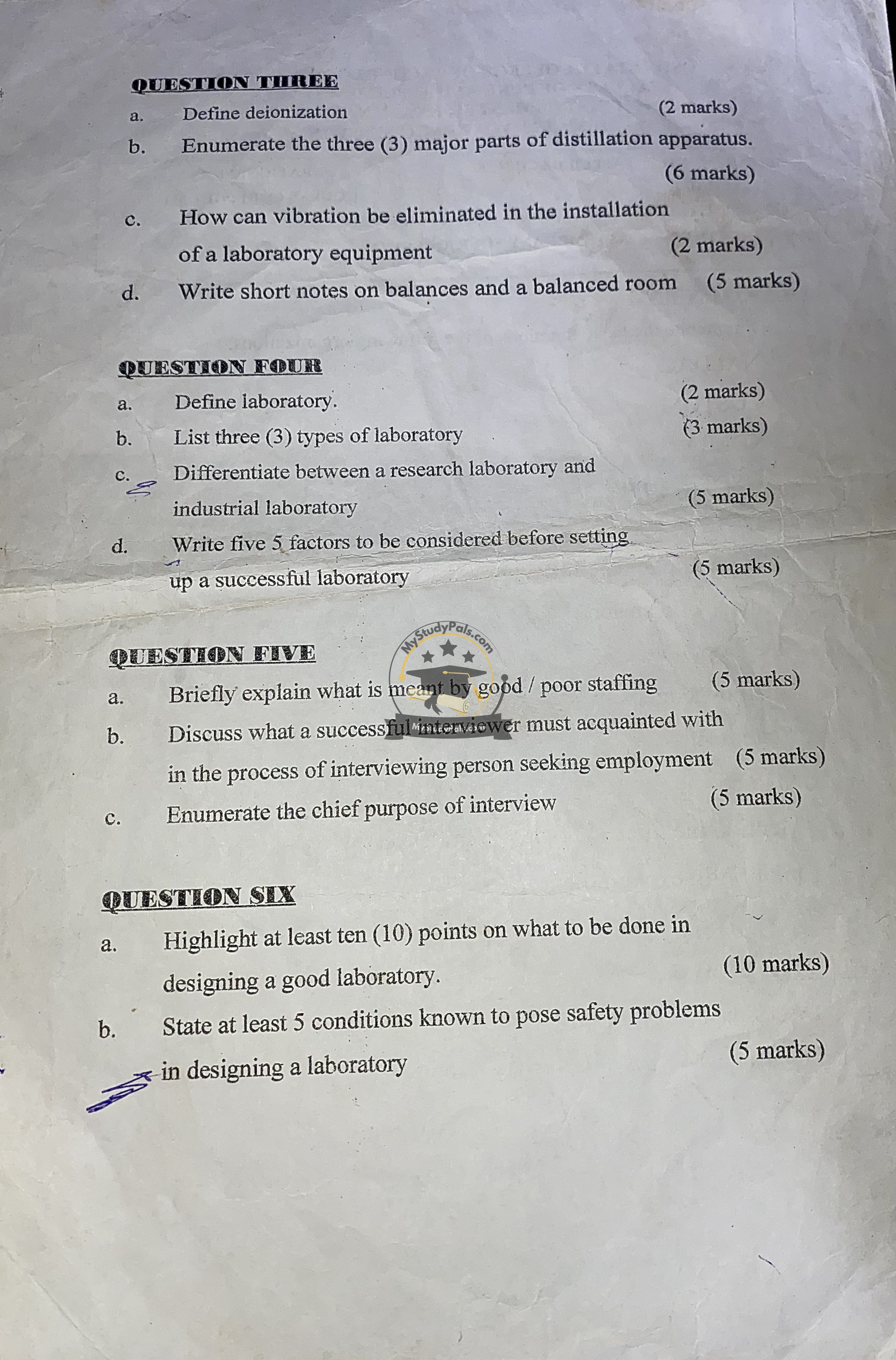ANWSER
—
Question 1:
a. Basic functions of the following organizations:
i. NAFDAC (National Agency for Food and Drug Administration and Control): Regulates and controls the manufacture, importation, exportation, distribution, advertisement, and use of food, drugs, cosmetics, medical devices, and chemicals in Nigeria.
ii. CUSTOM (Nigeria Customs Service): Responsible for collecting customs duties, controlling imports and exports, and preventing smuggling and illegal trade activities.
iii. NDLEA (National Drug Law Enforcement Agency): Combats the production, trafficking, and abuse of illicit drugs in Nigeria.
iv. NISLT (Nigerian Institute of Science Laboratory Technology): Promotes the development of science laboratory technology through training, certification, and regulation of laboratory professionals.
v. SONCAP (Standards Organization of Nigeria Conformity Assessment Program): Ensures imported products meet Nigerian industrial standards for quality and safety.
b. Brief explanations:
i. Advice of dispatch: A document sent by a supplier to inform the buyer that goods have been shipped, including details like shipment date and expected delivery.
ii. Delivery note: A document accompanying goods during delivery, listing the items shipped and serving as proof of delivery when signed by the recipient.
iii. Acknowledgement: A written confirmation that a document, payment, or goods have been received.
iv. Statement: A summary of transactions between a buyer and seller, typically showing amounts owed or paid over a period.
v. Invoice: A commercial document issued by a seller to a buyer, detailing the products/services provided, quantities, prices, and payment terms.
c. Types of stores and their explanations:
1. Central Store: A main storage facility where bulk materials are kept and distributed to smaller units or departments as needed.
2. Departmental Store: A smaller storage area within a specific department, holding materials frequently used by that department.
3. Bonded Store: A secure storage facility for high-value or sensitive items, often requiring special authorization for access.
—
Question 2:
a. Discussion of laboratory records:
Laboratory records are systematic documentation of all activities, procedures, and results in a laboratory. They ensure traceability, accountability, and compliance with standards. Records include experimental data, equipment logs, sample details, and quality control measures.
b. Types of laboratory records:
1. Experimental Data Records: Raw and processed data from experiments.
2. Equipment Logs: Maintenance, calibration, and usage history of lab equipment.
3. Sample Records: Details of samples received, tested, and disposed of.
4. Quality Control Records: Documentation of QC procedures and outcomes.
5. Standard Operating Procedures (SOPs): Written protocols for lab processes.
6. Inventory Records: Lists of chemicals, reagents, and supplies.
7. Safety Records: Incident reports and safety inspections.
8. Personnel Training Records: Staff qualifications and training history.
9. Environmental Monitoring Records: Temperature, humidity, and other lab conditions.
10. Waste Disposal Records: Documentation of hazardous waste handling and disposal.
—
Question 3:
a. Definition of deionization:
Deionization is the process of removing mineral ions (e.g., sodium, calcium, chloride) from water using ion-exchange resins, producing high-purity water for laboratory use.
b. Major parts of distillation apparatus:
1. Boiling Flask: Heats the liquid to form vapor.
2. Condenser: Cools the vapor back into liquid.
3. Receiving Flask: Collects the purified distillate.
c. Eliminating vibration in lab equipment installation:
– Place equipment on anti-vibration tables or pads.
– Ensure the lab floor is stable and level.
– Isolate equipment from sources of vibration (e.g., heavy machinery).
d. Short notes on balances and a balanced room:
– Balances: Precision instruments for measuring mass; types include analytical and top-loading balances.
– Balanced Room: A controlled environment with minimal air currents, vibrations, and temperature fluctuations to ensure accurate weighing.
—
Question 4:
a. Definition of laboratory:
A laboratory is a controlled environment equipped for scientific research, experiments, and analysis.
b. Types of laboratories:
1. Research Laboratory
2. Clinical/Medical Laboratory
3. Industrial Laboratory
c. Difference between research and industrial laboratories:
– Research Lab: Focuses on advancing scientific knowledge; experiments are exploratory and may not have immediate applications.
– Industrial Lab: Conducts applied research to develop or improve products/processes for commercial use.
d. Factors for setting up a successful laboratory:
1. Clear objectives and scope.
2. Adequate funding and budgeting.
3. Proper location and infrastructure.
4. Compliance with safety and regulatory standards.
5. Availability of skilled personnel.
—
Question 5:
a. Good/Poor Staffing:
– Good Staffing: Hiring qualified personnel with relevant skills, providing training, and ensuring adequate staff numbers for efficient operations.
– Poor Staffing: Insufficient or unqualified staff, leading to inefficiency, errors, and low morale.
b. Successful interviewer must be acquainted with:
– Job requirements and qualifications.
– Effective communication and active listening skills.
– Techniques to assess candidate suitability (e.g., behavioral questions).
– Legal and ethical considerations in hiring.
c. Chief purposes of interview:
1. Evaluate candidate’s skills and experience.
2. Assess cultural fit and personality.
3. Verify information provided in the resume.
4. Provide information about the organization.
5. Make an informed hiring decision.
—
Question 6:
a. Designing a good laboratory (10 points):
1. Ensure proper layout for workflow efficiency.
2. Include adequate ventilation and fume hoods.
3. Provide sufficient lighting and electrical outlets.
4. Use durable, chemical-resistant materials for surfaces.
5. Designate separate zones for different activities (e.g., wet lab, dry lab).
6. Incorporate safety features (e.g., emergency showers, fire extinguishers).
7. Plan for ergonomic furniture and equipment placement.
8. Ensure easy access to utilities (water, gas, electricity).
9. Include storage space for chemicals and equipment.
10. Comply with regulatory and accessibility standards.
b. Safety problems in laboratory design (5 conditions):
1. Poor ventilation leading to fume accumulation.
2. Inadequate emergency exits or safety equipment.
3. Cluttered workspaces causing tripping hazards.
4. Improper storage of hazardous materials.
5. Lack of signage or labels for safety protocols.
—



